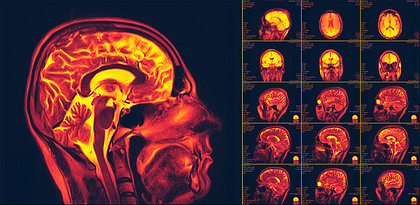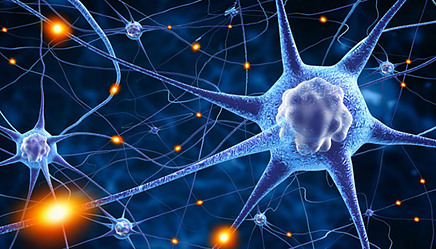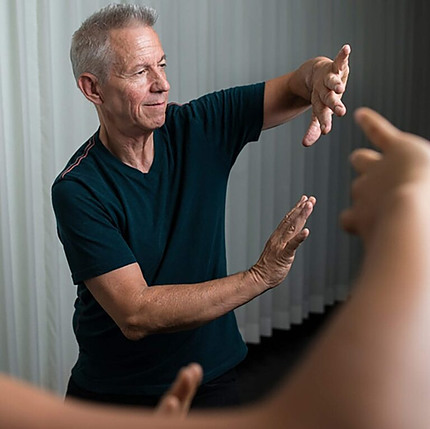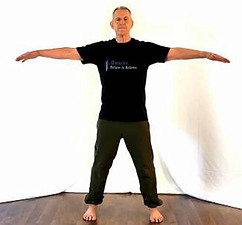What in the world is Corrective Neuroplasticity, and why should you care? Also, what does Qigong have to do with it and what is Qigong anyway?
What is Corrective Neuroplasticity
Corrective Neuroplasticity alludes to the brain’s ability to reorganize itself. When it performs this task, it forms different neural connections responding to changes in behavior, or if the environment has changed, such as a trauma. It’s a process through which the brain adapts and overcomes challenges. The brain also may be compensating for an injury or working to improve performance such as a new exercise that has been introduced.
connections responding to changes in behavior, or if the environment has changed, such as a trauma. It’s a process through which the brain adapts and overcomes challenges. The brain also may be compensating for an injury or working to improve performance such as a new exercise that has been introduced.
In the context of therapy, corrective neuroplasticity aims to use this ability of the brain to treat neurological and psychological conditions. It involves various techniques that encourage the brain to form new neural connections and pathways that support healthy behavior and functioning. This is where Qigong comes in.
Corrective Neuroplasticity Using Qigong
Corrective neuroplasticity using Qigong can be applied to various conditions such as stroke, traumatic brain injury, Parkinson’s disease, ADHD, and anxiety disorders, among others. The techniques used may include cognitive exercises, Qigong, physical therapy, and other forms of brain training that encourage the brain to adapt and learn new ways of functioning.
Parkinson’s disease, ADHD, and anxiety disorders, among others. The techniques used may include cognitive exercises, Qigong, physical therapy, and other forms of brain training that encourage the brain to adapt and learn new ways of functioning.
Qigong is an excellent method that can be used as a form of corrective neuroplasticity. Qigong is a traditional Chinese practice that involves slow movements, deep breathing, and visualization. It is often used to promote physical and mental well-being and has been found to have therapeutic benefits for various conditions.
Qigong and Brain Health
In terms of neuroplasticity, Qigong has been found to increase gray matter volume in various regions of the brain, including the hippocampus and prefrontal cortex. This increase in gray matter volume suggests that Qigong may help to stimulate neuroplasticity and promote the formation of new neural connections in these regions, which can support healthy cognitive and emotional functioning.
Furthermore, Qigong has been found to be effective in reducing symptoms of anxiety, depression, and chronic pain, among other conditions. These therapeutic effects may be related to the neuroplastic changes that occur in the brain as a result of practicing Qigong.
Overall, there is increasing evidence to suggest that Qigong can be an effective form of corrective neuroplasticity.
Scientific Studies relating to Qigong and Corrective Neuroplasticity
Here are some examples of studies that support this claim:
1. Increased gray matter volume: A study published in the journal Frontiers in Human Neuroscience found that practicing Qigong was associated with increased gray matter volume in several brain regions, including the hippocampus and prefrontal cortex. These regions are involved in cognitive and emotional processing and are considered important for neuroplasticity.
2, Improved cognitive performance: Another study published in the Journal of Alzheimer’s Disease found that practicing Qigong was associated with improved cognitive performance in older adults with mild cognitive impairment. The study authors suggested that this improvement may be related to neuroplastic changes in the brain.
3, Reduced symptoms of anxiety and depression: A systematic review and meta-analysis published in the Journal of Traditional Chinese Medicine found that Qigong was effective in reducing symptoms of anxiety and depression in individuals with various health conditions, including chronic pain and cancer. The study authors suggested that these therapeutic effects may be related to neuroplastic changes in the brain.
4, Improved motor function: A study published in the Journal of Rehabilitation Medicine found that practicing Qigong was associated with improved motor function in individuals with Parkinson’s disease. This improvement may be related to neuroplastic changes in the brain that support the development of new neural connections.
Does The Medical Community Support The Concept Of Corrective Neuroplasticity?
The concept of corrective neuroplasticity is generally supported by the medical community, although there may be varying levels of awareness and acceptance among different specialties and practitioners.
levels of awareness and acceptance among different specialties and practitioners.
Neuroplasticity refers to the brain’s ability to change and adapt in response to experiences, including learning, injury, and disease. Corrective neuroplasticity specifically refers to the process of intentionally inducing changes in the brain with exercises, affirmations, or medication, to promote recovery from neurological conditions, such as stroke, traumatic brain injury, or chronic pain.
There is a growing body of research demonstrating the potential of corrective neuroplasticity approaches, such as Qigong, neurofeedback, cognitive training, and brain stimulation techniques, to improve neurological function and promote recovery. These techniques are often used in conjunction with traditional medical interventions, such as medication or rehabilitation therapy.
While some medical professionals may still be skeptical or cautious about these approaches, the overall trend in the field is toward greater acceptance and integration of corrective neuroplasticity into clinical practice. As always, it is important to consult with a qualified medical professional before pursuing any treatment options for neurological conditions.
In Conclusion
While Qigong is not typically used as a tool for behavior modification, research suggests that it may have benefits in this area.
One study published in the Journal of Health Psychology found that practicing Qigong was associated with reduced stress and anxiety, and improved self-control and self-regulation. These benefits may make Qigong a useful tool for individuals looking to modify their behavior, such as by breaking unhealthy habits or improving self-discipline.
Another study published in the Journal of Alternative and Complementary Medicine found that Qigong was associated with improved mood and decreased impulsive behavior in individuals with depression. The study suggests that Qigong may help improve emotional regulation, which could in turn lead to better behavioral control.
My Personal Method
Personally, I use Qigong together with Affirmations,
Visualizations, and Breathwork. Combined, these tools provide
a powerful reprogramming tool for behavior modification, pain relief, and mindset training. If interested, feel free to connect with me through Qiworks

I must say you’ve done a really good job at explaining this article! I’ve heard of the term neuroplasticity before but was never able to actually put meaning to it, other than it being related to the brain in some way. I had no idea that Qigong could be used synergistically with neuroplasticity. I also really appreciate you adding other studies that further support your content as I always find myself wondering how true stuff is. How exactly do you have such knowledge on this topic? Did you work close to this industry?
Thanks for taking the time to read and comment!
Yes, I have been a Qigong practitioner for over 30 years. I use it in my clinic for helping to solve various types of pain. 2 years ago I implemented a program using Qigong with affirmations and breathwork for mindset change. It has been effective in working with folks with addictions.
Now I’m using it to help people get out of stuck thinking so they can realize their full potential.
Thanks for asking.
Stay well and keep thriving!
Al
Very interesting article, neural plasticity is a very interesting topic that I’m really curious about. I’ve read a lot of articles about nureoplasticity from doing certain activities such as playing chess, playing a musical instrument, or experiencing different activities that can stimulate the brain, those equaling neuroplasticity. Also I’ve read of that about supplements such as fish oil which also promotes brain changes in placisity as well. Thank you for this article, will be looking for more o your articles in the future.
One of the amazing things about the human brain is its ability to reorganize itself which is called corrective neuroplasticity. I am pretty sure that things would be a lot different should the brain not be able to adapt and overcome challenges.
Having lived in Hongkong for almost 10 years, I am very familiar with qigong because every day when I go to work, I see people of all ages doing qigong exercises at the park. However, I had no idea about the benefits of qigong exercises other than some kind of activity that is good for one’s health and well-being.
Since qigong also reduces stress and anxiety, I really hope more and more people will resort to this activity. We live in a fast-paced society which often causes us to stress out and be anxious.
Thank you for a very informative post.
Thanks, Alice, for taking the time to read and respond.
Qigong is a wonderful tool.
If more folks practiced it, there would be far less stress I our lives.
Using affirmations and visualization in connection with the exercises makes Qigong even more potent!
Keep on thriving!
Al
Thank you so much for your helpful article. You mentioned great details that are amazingly updated. If I understand correctly, Corrective Neuroplasticity can provide the conditions for the lost connections in the brain to re-emerge, and this causes many brain and mental diseases to be relieved. In my opinion, this is a great development and it will help many people to get rid of their pain.
I appreciate this very informative article. Even though I have been practicing Qigong for about 20 years I did not realize its relation to corrective neuroplasticity. I have studied neuroscience and am familiar with neuroplasticity but not as related to Qigong. I have found Qigong helpful in increasing physical stamina and overall health benefits, including reducing stress and anxiety. I use Qigong along with yoga, Tai Chi, meditation, and other exercises to stimulate the endocrine glands and lymphatic system. Thanks for providing me with this additional information.
The idea of using physical movement and breathing to encourage neuroplasticity is very interesting. I know that years ago studies were done regarding various kinds of external stimulation like music or smells, etc. to modify what was then call neurolinguistic programing with the idea that neurons could be reconnected to learn in different ways. (I think if I remember correctly.). This concept kind of follows that except with a different type of external stimulation. I am wondering if relaxation and peaceful movement aren’t the key. Very interesting.
Jim
Thanks for taking the time to read and respond, Jim.
Yes, the Qigong movements are slow, and together with synchronized deep breathing, relaxes both the body and mind, making the changes in the dendrites of the neurons work more rapidly. Under stress we don’t learn as easily. Neuroplasticity takes place every time the mind learns something. Using affirmations with the gentle movement of Qigong enhances that process.
Al
Great read! This “What is Corrective Neuroplasticity” article is very interesting. It is amazing as to how the brain can, in some instances, rewire itself. I had no idea that Qigong could be use as a technique for neuroplasticity. How does Qigong technique perform synaptic strengthening? Are the improvements at the cellular level? And is it a continuous process or limited?
Thanks for taking the time to read and respond, Canty!
Dendrites are clusters of antenna like protrusions at the end of the brain’s neurons. They receive impulses and pass them as synapses to the neuron. When we learn something the dentritic cluster gets larger. Ex: riding a bike, the cluster remains intact to aide in remembering the action. The Qigong exercises are repetitive like bike riding. Adding affirmations and breath work creates new clusters of dentrites that override old thought patterns such as addictions or negative thinking. The affirmations together with the repetitive movement and breath work make the cluster very strong.
Thank you for sharing such useful and interesting information about this technique. The application of this technique to patients with Parkinson’s disease calls my attention. I have the following question, is there any risk associated with the application of this technique in patients with Parkinson’s when the deterioration of motor function is advanced?
Thanks for taking the time to read and respond, Pablo.
There is no risk. The exercises can be done seated for those who are impaired.
Hi, Perry, this is wonderful!! You know the brain is one organ that is hard to manage if anything goes wrong. And medications may not always induce the mechanism of self-correction or neuroplasticity. I get it that through exercising using the Qigong technique, you are like providing the brain, which had degenerated due to any of the causes, some tasks to solve. Since one does it slowly and routinely, the brain wakes up to the task to try to solve the problem. It must then grow new brain cells and neural networks. I wish the medical profession embraces these techniques, so many people with brain injuries will be helped. Once again, thank you, Perry, for this post.
Thanks for taking the time to read and respond.
Yes, Qigong is a wonderful tool for life!
Keep on thriving!
Al
The brain is amazing and increasingly it is becoming clear that there are ways in which to reprogram the brain, and corrective neuroplasticity is one way. To find that traditional Chinese medicine, like Qigong, can be used to facilitate corrective neuroplasticity, is indeed awesome. It is far better to use Qigong for healing, than chemical or surgical intervention, specially for mental conditions like depression and anxiety..
I recently attended my first breath workshop,so find it interesting that you use Qigong in combination with breathwork, affirmation and visualization. Can you give more details as to how you combine these practices? Thank you.